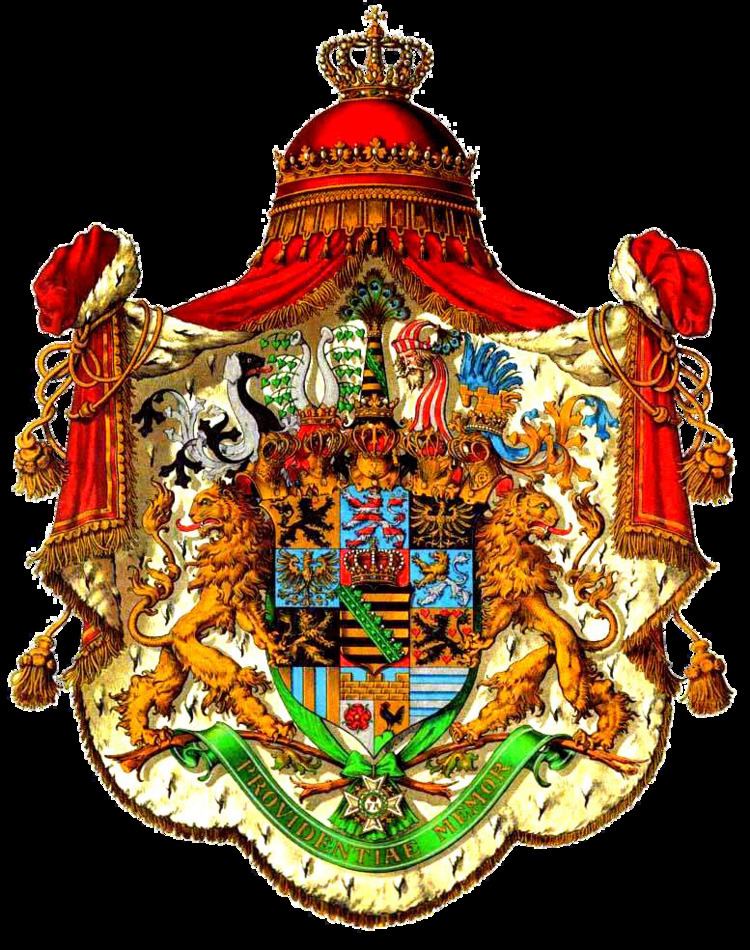Style His Majesty Last monarch Frederick Augustus III Abolition 13 November 1918 | First monarch Hadugato Formation 531 Appointer Hereditary | |
 | ||
This article lists Dukes, Electors, and Kings ruling over different territories named Saxony from the beginning of the Saxon Duchy in the 9th century to the end of the Saxon Kingdom in 1918.
Contents
- Counts Palatine of Saxony
- Dukes of Saxony
- Early dukes
- Hattonid Dynasty
- Welf Dynasty
- Ascanian or younger Duchy of Saxony
- Dukes of Saxe Lauenburg
- Dukes of Saxe Lauenburg 14011876
- Dukes of Saxe Wittenberg
- Albertine Dukes of Saxony
- Ernestine Dukes of Saxony
- Electors of Saxony
- Kings of Saxony
- Heads of the House of Wettin since 1918
- References
Counts Palatine of Saxony
See Counts Palatine of SaxonyIn the 10th century the Emperor Otto I created the County Palatine of Saxony in the Saale-Unstrut area of southern Saxony. The honour was initially held by a Count of Hessengau, then from the early 11th century by the Counts of Goseck, later by the Counts of Sommerschenburg, and still later by the Landgraves of Thuringia.
Dukes of Saxony
The original Duchy of Saxony comprised lands of the Saxon people in the north-western part of present-day Germany, namely, the contemporary German state of Lower Saxony as well as Westphalia and Western Saxony-Anhalt, not corresponding to the modern German state of Saxony.
Early dukes
Hattonid Dynasty
Welf Dynasty
With the final removal of the Welfs in 1180, the Duchy of Saxony was sharply reduced in territory. Westphalia fell to the Archbishop of Cologne, while the Duchies of Brunswick and Lüneburg remained with the Welfs. The Ascanian Dukes had their base further east, near the Elbe, resulting in the name Saxony moving towards the east. The post carve-up Saxony is therefore sometimes called the younger Duchy of Saxony. Also the counting of its dukes is discontinued. While the first post carve-up duke is competingly counted as Bernard III—because of two predecessors of the same name before 1180—or as Bernard I with his great-great-great-great grandson Bernard II being counted second. The second post carve-up duke Albert I is already usually counted as the first, although before 1180 he had one predecessor of the same name, being even his grandfather Albert the Bear.
Ascanian or younger Duchy of Saxony
The new dukes replaced the Saxon horse emblem () and introduced their Ascanian family colours and emblem () added by a bendwise crancelin, symbolising the Saxon ducal crown, as new coat-of-arms of Saxony (). The later rulers of the House of Wettin adopted the Ascanian coat-of-arms.
Dukes of Saxe-Lauenburg
Since the Duke of Saxony was considered one of the prince-electors electing a new Holy Roman Emperor, conflict arose between the lines of Lauenburg and Wittenberg over the issue of who should cast Saxony's vote. In 1314 both lines found themselves on different sides in a double election. Eventually, the Dukes of Saxe-Wittenberg succeeded in 1356 after the promulgation of the Golden Bull. To distinguish him from other rulers bearing the title Duke of Saxony, he was commonly called Elector of Saxony.
Dukes of Saxe-Lauenburg (1401–1876)
The Ascanian Dynasty continued in Saxe-Lauenburg until 1689, but after the Lauenburgish line had finally lost the Saxon Electorate to the Wittenberg line in 1356 and failed to obtain the succession in the Electorate after 1422, recognition of the Dukes of Saxe-Lauenburg as Dukes of Saxony waned.
Dukes of Saxe-Wittenberg
For the predecessor see the section Ascanian or younger Duchy of Saxony above in this article.
Albertine Dukes of Saxony
The Albertines were a junior branch of the Wettin dynasty of Electors of Saxony (section below), who ruled in Northern Thuringia and Southern Meissen until they replaced the senior "Ernestine" branch as Electors and rulers of most Saxon territory in 1547.
Ernestine Dukes of Saxony
Following their displacement by the Albertines, the Ernestine branch of the Wettins continued to rule in southern Thuringia as "Dukes of Saxony", but their lands eventually split up into many different tiny "Ernestine duchies". Of these, Saxe-Weimar-Eisenach, Saxe-Coburg-Gotha, Saxe-Meiningen, and Saxe-Altenburg lasted until 1918. This article does not list the subsequent Ernestine dukes.
Electors of Saxony
The Golden Bull of 1356 confirmed the right to participate in the election of a Holy Roman Emperor to the Duke of Saxony in the Saxe-Wittenberg line. For the predecessor see the section Ascanian Dukes of Saxe-Wittenberg above in this article.
Kings of Saxony
The Holy Roman Empire came to an end in 1806. The Elector of Saxony, allied to Napoleon I, anticipated its dissolution by becoming the ruler of an independent Kingdom of Saxony in 1806.
Heads of the House of Wettin since 1918
The legal line of succession of the house of Wettin has continued to the present, although the house no longer plays any political role. For later rulers, see List of Ministers-President of Saxony.
